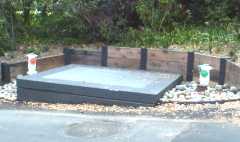|
In communities that are spread over a number of hills there are often pockets
of homes in low places where water main pressures would be excessive. Where the
number of customers are insufficient to warrant a separate reservoir and distribution
system, large regulator sets can be placed on the distribution mains to control
water pressure at the lowest end of the system and maintain pressures at an acceptable levels.
Five small pressure zones in Orinda are supplied through regulator sets.
Four of these sets were in the original Orinda Fire District. One set, the Whiteoak
Regulator zone which serves only two hydrants in Orinda
is located in east Orinda territory recently annexed into the district.
Orinda's regulator sets were installed in the 1930s and 1940s when
design criteria did not consider modern fire flow requirements.
Consequently, as the community and its needs grew these regulator sets
became "choke points" for emergency high-volume water delivery into the
water mains which they supplied. Additionally they were primitive in operation
and when downstream appliances such as fire hydrants were closed too quickly, they
the old regulators tended to slam shut and cause significant upstream water hammer.
While the concept may seem simple, modern regulator sets are a complex
assembly of several large and expensive regulator devices, each set to open
at a slightly different pressure so that the impact of sudden decrease in demand on the
water system can be cushioned, minimizing water hammer and other potential
problems. These devices are located in underground vaults and a modern
assembly can cost upwards to a quarter million dollars.
|
|
NEW REGULATOR SETS AND VAULTS INSTALLED
|
 The regulators are set in pits which have a regular "vault" covering.
The regulators are set in pits which have a regular "vault" covering.
Nearby or at either side of the regulator are two fire hydrants. One hydrant
is connected to the high pressure side of the regulator. The other hydrant is
connected to the regulated side. Both hydrants can be used for firefighting.
Since the regulated hydrant is taking supply from the same original
feed as the high pressure hydrant (albeit through the regulator set), the additional volume available from the
second hydrant may be limited.
Of greater consequence is the ability to bypass the regulator set with hoses
connected between the hydrants in the event that the regulator fails to operate
properly or if needed fire flows exceeded the throughput capacity of the regulator
set. Such action, however, would only be taken in extenuating circumstances as
directed by an on-scene EBMUD Field Supervisor and would have to be closely monitored.
Fire District Procedure:
- If ordered or authorized to do so by an EBMUD Field Supervisor, the engine company assigned to
bypass the regulator shall take suction from the higher pressure (green cap) hydrant and prepare to discharge
into the lower pressure (orange cap) hydrant.
- The Engineer shall determine the static pressure on the lower pressure (regulated) hydrant prior to bypassing
by either noting the static pressure which is stenciled on the hydrant or taking a gauge reading prior
to bypassing water.
- The Engineer shall maintain a bypass pressure of not more than 10 p.s.i. above the static pressure on the regulated zone.
- A gauge may be attached to the discharge hydrant which can be monitored and the flow rate controlled by adjusting the
hydrant valve.
- The bypass can be made through the engine using the engine valves and gauges to maintain appropriate flow rates.
- For sustained operations a pressure controlled dump valve (provided by EBMUD) should be attached to the low pressure
hydrant in order to relieve excess pressure.
- EBMUD shall be notified immediately upon termination of the pump-around operation so that
appropriate testing of the water system for sanitary purposes can be expedited.
|